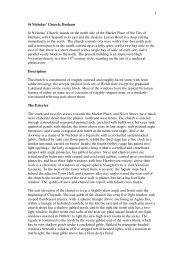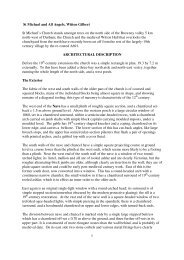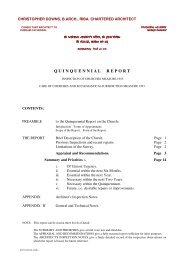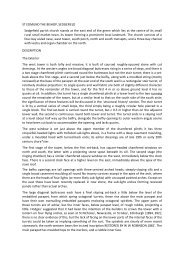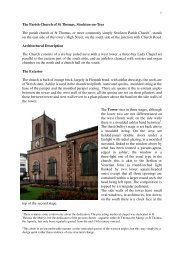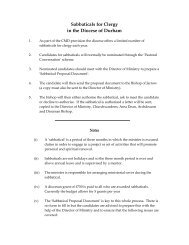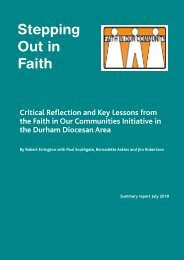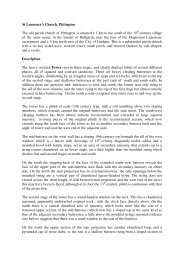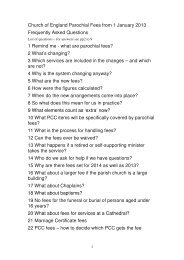St John the Evangelist, Kirk Merrington The parish church of Kirk ...
St John the Evangelist, Kirk Merrington The parish church of Kirk ...
St John the Evangelist, Kirk Merrington The parish church of Kirk ...
You also want an ePaper? Increase the reach of your titles
YUMPU automatically turns print PDFs into web optimized ePapers that Google loves.
<strong>the</strong> Society <strong>of</strong> Antiquaries <strong>of</strong> Newcastle (New Series IV, 21) states that ‘in <strong>the</strong> <strong>church</strong>yard are<br />
eleven medieval grave covers, almost overgrown with grass, several are coped and one is<br />
fur<strong>the</strong>r decorated with a tile pattern...’‘ In <strong>the</strong> next volume <strong>of</strong> <strong>the</strong> same periodical (891/2 ,<br />
New Series V, 103) it is noted that <strong>the</strong> Rev R. Coulton, <strong>the</strong>n vicar, had taken seven <strong>of</strong> <strong>the</strong><br />
grave-covers from <strong>the</strong> <strong>church</strong>yard and placed <strong>the</strong>m inside <strong>the</strong> <strong>church</strong>, within <strong>the</strong> communion<br />
rails, including <strong>the</strong> small double slab (5, above) and four coped slabs, two with tegulated<br />
sides. So were <strong>the</strong>re originally twelve slabs? A sketch accompanying <strong>the</strong> second note (left)<br />
shows <strong>the</strong> coped slab now in <strong>the</strong> north transept, and <strong>the</strong> second, now missing, with a plain<br />
end, a roll-moulded ridge, and semicircular tegulations on <strong>the</strong> sides.<br />
<strong>The</strong> unpublished manuscript ‘Memorial Floor Slabs in England and Wales’ compiled by <strong>the</strong><br />
Rev. George Rowe (British Museum Additional MS 39912-6), includes drawings <strong>of</strong> five<br />
cross slabs from <strong>Kirk</strong> <strong>Merrington</strong>, four <strong>of</strong> which are no longer traceable - vol.III p.121 and<br />
vol.IV, pp 24, (‘taken from a rubbing by Dr Charlton’) 48 & 70. (Copies at end <strong>of</strong> this report)<br />
So it would seem possible that <strong>the</strong>se four slabs, and <strong>the</strong> second tegulated one, had been taken<br />
into <strong>the</strong> <strong>church</strong>, but were later removed. Rowe also illustrates, on p.41 in volume I, a small<br />
slab from ‘Durham Ca<strong>the</strong>dral Crypt’, labelled ‘from <strong>Kirk</strong> <strong>Merrington</strong>’ ; this is an unusual<br />
small monument with arcaded sides, no.10 in <strong>the</strong> ca<strong>the</strong>dral refectory undercr<strong>of</strong>t collection<br />
(Ryder 1985, 75 and plate 19).<br />
Dodd (1897, 50-51) provides some intriguing information that may relate to Cumin’s defence<br />
works. He states that ‘right across <strong>the</strong> <strong>church</strong>yard. From Mr Bruces’s grave (presumably that<br />
<strong>of</strong> Rev Charles <strong>John</strong> Bruce d.1887, at <strong>the</strong> extreme north-west corner) to <strong>the</strong> fire-hole (boiler<br />
room) door <strong>of</strong> <strong>the</strong> <strong>church</strong>, <strong>the</strong>re is a trench filled with layer upon layer <strong>of</strong> unc<strong>of</strong>fined bones.<br />
Part <strong>of</strong> <strong>the</strong> trench is in <strong>the</strong> modern extension <strong>of</strong> <strong>the</strong> <strong>church</strong>yard, and <strong>the</strong> sexton can tell at once<br />
when he comes to it, because <strong>the</strong> earth is easier to dig than on <strong>the</strong> adjoining sides, and it is no<br />
uncommon circumstance for skulls and bones to be thrown out by <strong>the</strong> gravedigger’s spade.<br />
Possibly <strong>the</strong> bodies may be those <strong>of</strong> soldiers slain during Cumyn’s rebellion.<br />
Looking along <strong>the</strong> line that Dodd describes, <strong>the</strong>re are one <strong>of</strong> two graves which appear to have<br />
sunk bodily into <strong>the</strong> ground, which would seem to confirm his reference to s<strong>of</strong>ter earth in this<br />
area. His reference to <strong>the</strong> ‘modern extension’ is puzzling, as even <strong>the</strong> 1840 ti<strong>the</strong> map shows<br />
<strong>the</strong> <strong>church</strong>yard <strong>of</strong> exactly <strong>the</strong> same dimensions as at present. Perhaps <strong>the</strong>re had been a strip<br />
along <strong>the</strong> western margin that had not been used for burials prior to <strong>the</strong> mid-19th century.<br />
Archaeological Assessment<br />
It would seem reasonable to much <strong>of</strong> <strong>the</strong> present <strong>church</strong> was rebuilt from foundation level in<br />
1850/1, with <strong>the</strong> probable exception <strong>of</strong> parts <strong>of</strong> <strong>the</strong> tower and chancel walls. Any works<br />
involving large-scale plaster removal from internal wall faces should be monitored, as <strong>the</strong>y<br />
may provide more information on <strong>the</strong> extent <strong>of</strong> surviving medieval fabric. Presumably <strong>the</strong>re<br />
are also some remains <strong>of</strong> sub-floor deposits (and possibly structural remains) within <strong>the</strong><br />
present building, although what <strong>the</strong>re is will have been disturbed by a sub-floor heating<br />
system and, <strong>of</strong> course, many generations <strong>of</strong> burials. Never<strong>the</strong>less, any disturbance <strong>of</strong> <strong>the</strong><br />
ground within <strong>the</strong> building will still merit some degree <strong>of</strong> archaeological monitoring.<br />
Outside <strong>the</strong> building, in <strong>the</strong> <strong>church</strong>yard, <strong>the</strong>re may be more <strong>of</strong> interest. No definite remains <strong>of</strong><br />
<strong>the</strong> documented defensive ditch around <strong>the</strong> <strong>church</strong>, dating from Cumin’s rebellion, have been<br />
traced - even <strong>the</strong> earliest antiquaries note this - but sub-surface remains presumably survive<br />
13




